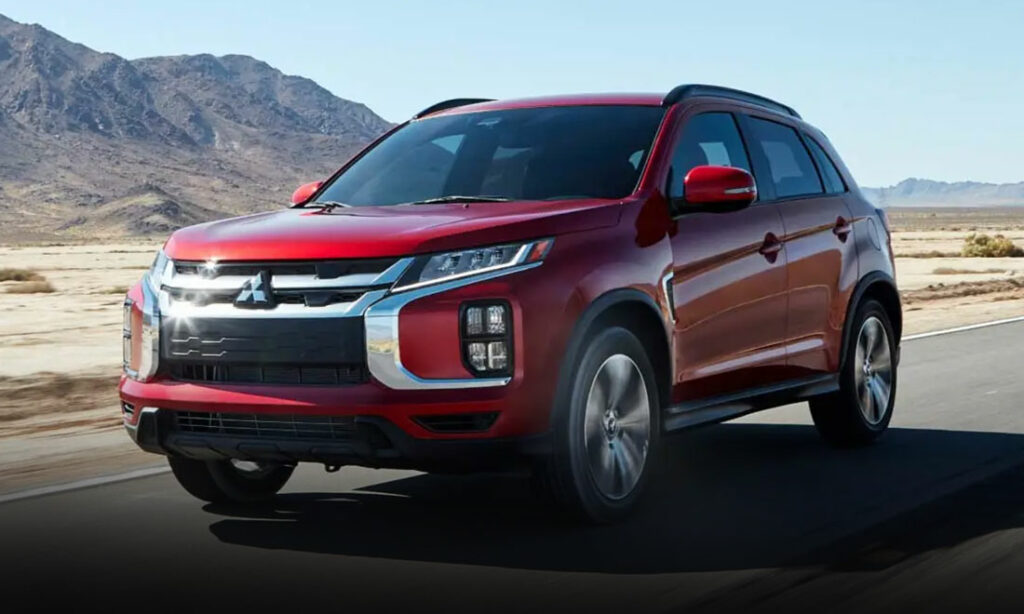Retro Review: Dodge Li’l Red Express
A look back at the Dodge Li’l Red Express, one of the wildest high-performance trucks to ever come from Detroit and known as the “last American hot rod.”
Dodge Li’l Red Express: The Last American Hot Rod

If you’ve ever seen a Dodge Li’l Red Express truck, you may have marveled at the level of customization the owner must have taken to dress up an old D100 in such wild clothes. In fact, those shimmering exhaust stacks, real wood paneling, and gold decals were a factory creation. Not only that, the Lil’ Red Express was a serious high-performance machine in an age of rapidly disappearing muscle cars. As such, its creator Tom Hoover dubbed this bright red truck “the last American hot rod.”
The name itself pulls from the earlier Little Red Wagon of the Dodge A100 lineup, which we look back on here. But poring over photos of the Li’l Red Express, with its almost cartoonish vibe, it is hard to imagine that any automaker would have put such a vehicle on the road. However, if you can close your eyes and drift back to the late 1970s for a moment, it will begin to make more sense. Particularly when you consider this was an era that saw Dodge selling an “Adult Toys” collection of limited-edition trucks and SUVs.
Pickup Trucks that March (or Drive) to Their Own Beat

Nameplates included Warlock and Macho Power Wagon Top Hand, a package you could find on the equally gnarly-sounding Ramcharger. Advertisements showed off Dodge vans with a giant male gender symbol running the length of the truck and scantily-clad ladies. And though competitors were selling sweet trucks like the classic Chevy C10, no one was doing things quite like Dodge. To say it was a different time is an understatement, but one that helps put you in the mindset for how the Li’l Red Express came to life.
It was also a time that saw high-performance muscle cars like the ‘Cuda and Super Bee end up on the chopping block. An oil embargo, insurance industry clampdown and increasingly stringent federal emissions requirements effectively put a stop to 426 HEMIs and 6-barrel induction. On top of that, 4-cylinder import models were gaining popularity as was vehicle customization in favor of performance upgrades.
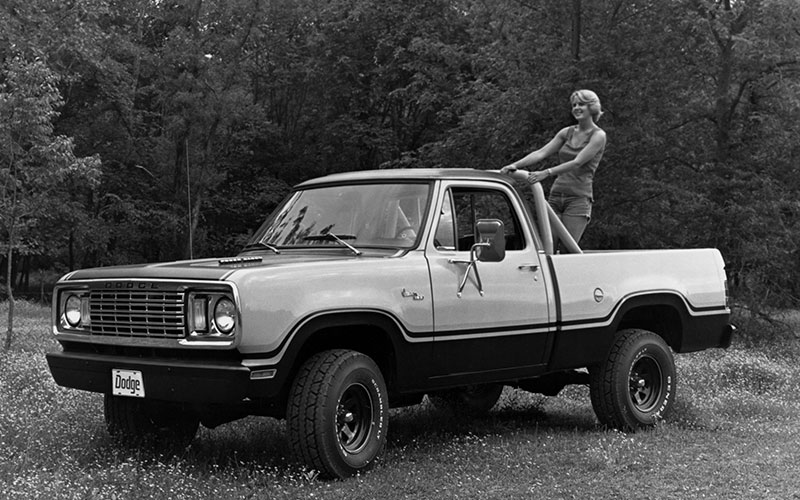
The nail in the thundering and thirsty V8 coffin was the catalytic converter that, in the 1970s, became required equipment and subsequently sucked the power out of the mighty American muscle car era. Fortunately, Tom Hoover, renowned Chrysler engineer referred to as “Father of the HEMI”, wasn’t ready to give up the ghost and got to work studying all the latest industry rules and regulations to make sure they weren’t missing anything. Turns out something did get missed.
The Loophole that Led to the Lil’ Red Express
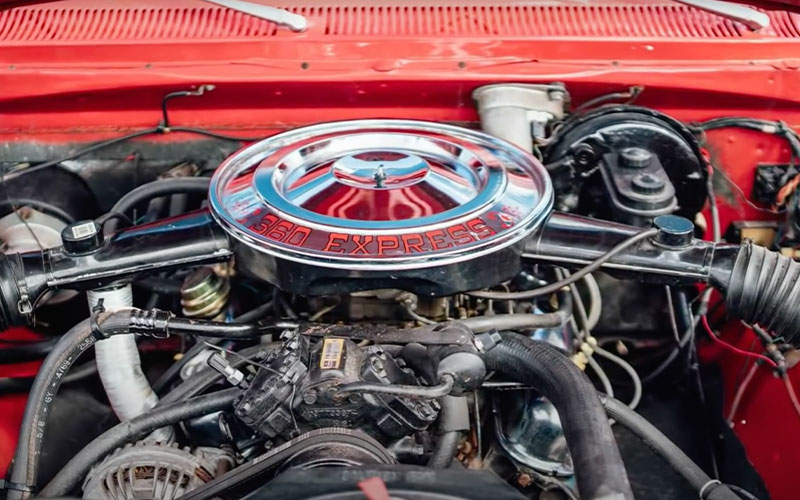
That would be a loophole big enough to drive a 360 CID V8-powered Dodge D100 through. You see, the new emissions regulations were required for cars, any vehicle with a gross vehicle rating of 6,100 pounds or more was exempt. Meaning, no catalytic converter required. On top of that, for reasons unknown, the rules stated that engines which had already been certified as emissions-compliant could be modified without having to re-run the full certification cycle. With the light bulb illuminated, Mr. Hoover and Team Mopar got to work on turning a D100 into the Li’l Red Express.
While Chrysler’s thumping 440 cubic inch mill would seem an obvious choice for the soon-to-be hot rod, it was scheduled to be deleted so they went with the tried-and-true 360 V8 power plant. But not just any old 360, this project would start with the high performance small-block used in police interceptor vehicles. The aluminum intake was replaced with a cast-iron piece and the 650-cfm ThermoQuad 4-barrel carburetor was upgraded to an 850-cfm unit.
Modifications continued with a dual-snorkel air cleaner, aggressive camshaft, beefier valve springs, heavy-duty main bearings, and more. Transmission duty was handled by a 3-speed 727 LoadFlite fitted with a valve body out of the 440 cars. Power was routed to 3.55:1 rear end with a “Sure Grip” axle and limited-slip differential. And of course, there are the signature chromed vertical exhaust stacks wrapped in stainless-steel heat shields, fed by straight-piped Hemi-style mufflers – a unique method of customization we discuss here. These ludicrous exhaust stacks would seem to have been a blatant thumbing-of-the-nose from Mopar to the government. But Mopar being Mopar, they didn’t stop there.
1978: The First Year of the Lil’ Red Express
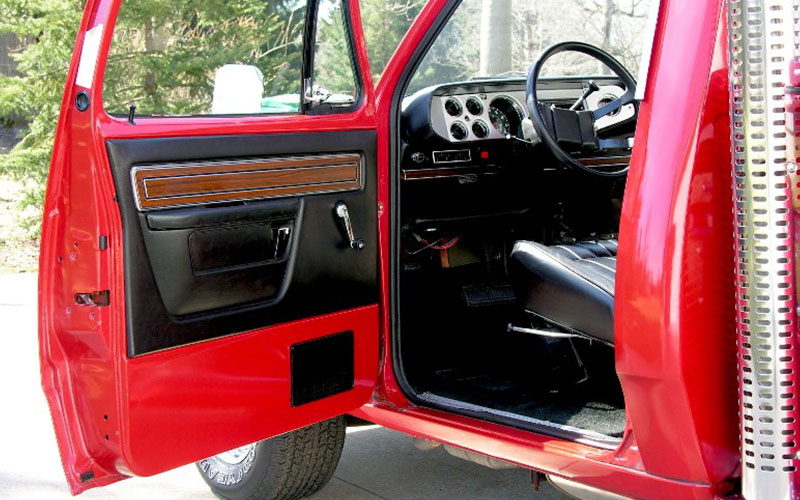
The first Li’l Red Express, which arrived in 1978, backed up its high performance bona fides with in-your-face design. Outside, you could have any color as long as it was Bright Canyon Red with oak body panels, gold pinstripes, and giant gold decals on the doors proclaiming exactly what the driver was driving. Inside, you could swap the bench for optional bucket seating that was offered in red or black. Outside, the truck sat on 15-inch chrome wheels sized 7-inches wide up front and 8-inches wide out back.
It was a huge hit, selling over 2,100 units in that first year of production, 1978. The following – and final – year, the Li’l Red Express was mildly facelifted with dual square headlights instead of the prior single round setup and received 8-inch-wide rubber all around. It also ended up saddled with a catalytic converter and silly 85-mph speedometer. Part of the federal government’s effort to slow drivers down, it was a moot point as the Li’l Red hot rod was capable of well over 100 mph. In fact, it was found to be the fastest domestic vehicle – in any category – from 0-100 mph in 1978. Meaning it could smoke the likes of a Corvette and Trans Am of the same period.
When the Li’l Red Express was hitting those high speeds, cabin noise was recorded at an ear-splitting 94 decibels. It would have been even louder had the engineers gotten their way and been allowed to install the big rig-style exhaust stack flappers they had in mind. No matter, the Li’l Red Express was brash, fast, and crazy loud, which is precisely what Mopar was hoping to accomplish.
Fun fact: The Lil’ Red Express Was Not Available Everywhere
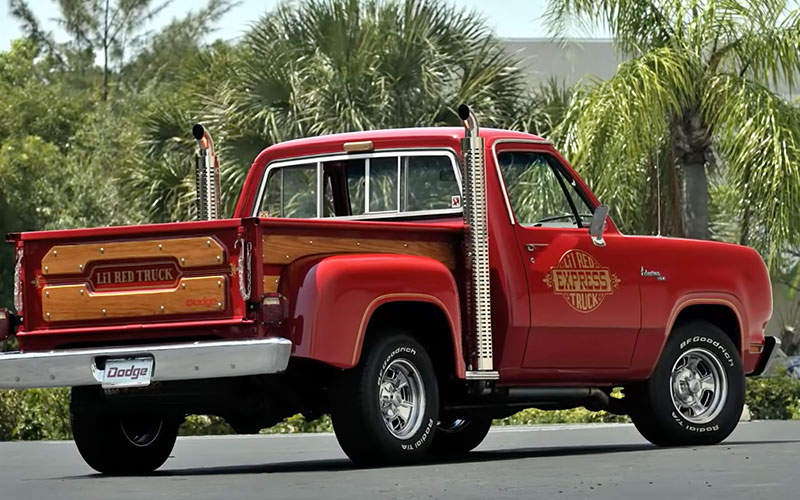
This wild truck was not made available for sale in a handful of states like California and Florida because it did not meet noise standards. That is exactly the kind of PR the Dodge brand has been cultivating for the past 50 years and one of the many reasons the Li’l Red Express is such an important part of their history. That significance continues to this day where well-kept examples are now trading hands for nearly $40,000, perhaps no surprise considering fewer than 7,500 of these outrageous hot rods were ever made in a short two-year span.



